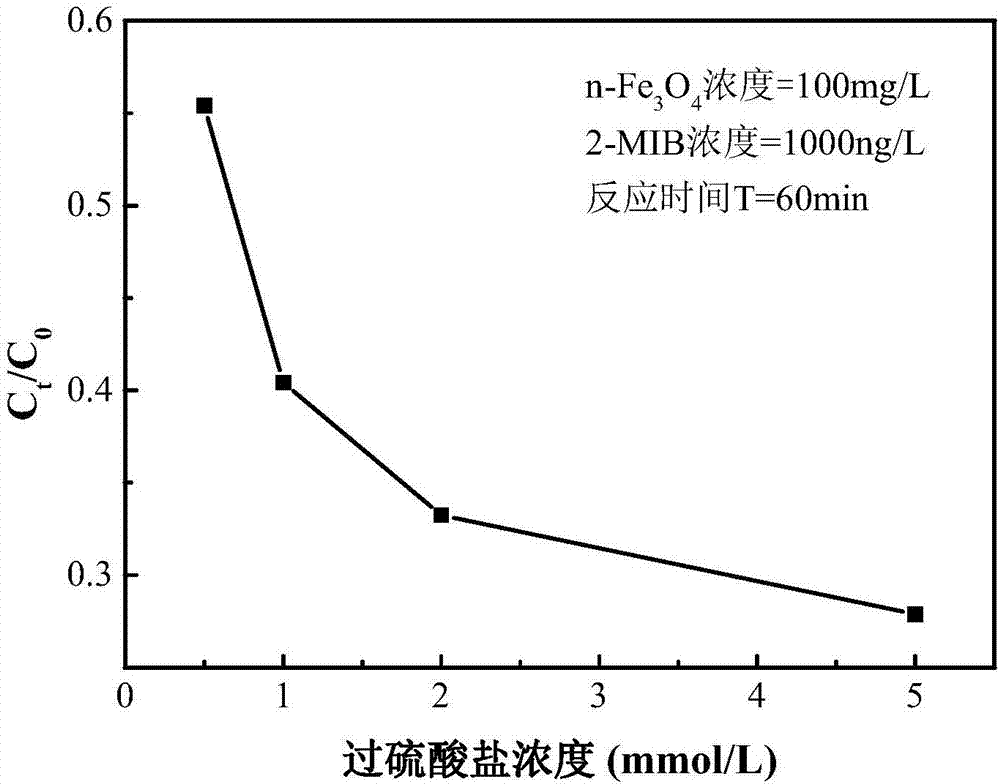Method for activating persulfate to degrade odor compound in water by virtue of magnetic nanoparticle
A technology of magnetic nanoparticles and persulfate, applied in chemical instruments and methods, magnetic field/electric field water/sewage treatment, water/sewage treatment, etc., can solve problems such as inability to catalyze and oxidize odor substances well, and achieve improvement Catalytic efficiency, high effective utilization rate, and large specific surface area
- Summary
- Abstract
- Description
- Claims
- Application Information
AI Technical Summary
Problems solved by technology
Method used
Image
Examples
Embodiment 1
[0039] (1) Determination of dimethylisoborneol (2-MIB) standard by internal standard method. In the headspace bottle of 20mL, add 3g NaCl, 200uL concentration and be the IB internal standard of 10ug / L and the magnetic stirrer bar, add the dimethylisoborneol (Dimethylisoborneol ( 2-MIB), and finally add ultrapure water to prepare a 10mL water sample so that the concentration of dimethylisoborneol in each headspace bottle is 10, 50, 80, 100, 200, 500 and 1000ng / L, immediately Seal with a cap with a PTFE-coated silicone rubber gasket. Determination of Odor and Taste Substances in Water by Headspace Solid Phase Microextraction-Gas Chromatography / Mass Spectrometry. Specific steps: first place the headspace bottle in a water bath constant temperature magnetic stirrer (SHJ-2C), pierce the solid-phase microextraction needle through the sealed silica gel pad inside the bottle cap, and push out the extraction head to expose to the headspace. Set the temperature at 65°C, rotate at 300r...
Embodiment 2
[0046] On the basis of the method in Example 1, the concentration of 2-MIB is 1000ng / L, the concentration of persulfate is 0.5mmol / L, 1mmol / L, 2mmol / L and 5mmol / L, Fe 3 o 4 The concentration of nanoparticles is 100mg / L, and the reaction time is 60min. Under these conditions, the Fe 3 o 4 Nanoparticles catalyzed the degradation efficiency of different concentrations of persulfate to degrade 2-MIB. The experimental results are as image 3 shown.
[0047] This example uses Fe 3 o 4 Nanoparticles catalyzed the activation of persulfate to degrade odorous substances in water, and the degradation efficiency increased with the increase of persulfate concentration, but when the persulfate concentration exceeded 1 mmol / L, the relative degradation efficiency decreased significantly. Therefore from the consideration of economy and efficiency, the preferred persulfate concentration of this patent is 1mmol / L.
Embodiment 3
[0049] On the basis of the method in Example 1, the concentration of 2-MIB is 1000ng / L, the concentration of persulfate is 1mmol / L, Fe 3 o 4 The concentration of nanoparticles is 20mg / L, 50mg / L, 100mg / L, 200mg / L, 300mg / L and 500mg / L, and the reaction time is 60min. Under these conditions, different concentrations of Fe were measured 3 o 4 Degradation efficiency of nanoparticles catalyzed persulfate degradation of 2-MIB. The experimental results are as Figure 4 shown.
[0050] This example uses Fe 3 o 4 Nanoparticles catalyze the activation of persulfate to degrade odor and odor substances in water, and the degradation efficiency varies with Fe 3 o 4 significantly increased with increasing concentrations of nanoparticles. When Fe 3 o 4 When the concentration of nanoparticles is greater than 400mg / L, the Fe produced by hydrolysis 2+ Consumed more sulfate radicals and made the degradation efficiency lower, so the Fe used in the present invention 3 o 4 The concentra...
PUM
| Property | Measurement | Unit |
|---|---|---|
| clearance rate | aaaaa | aaaaa |
Abstract
Description
Claims
Application Information
 Login to View More
Login to View More - R&D Engineer
- R&D Manager
- IP Professional
- Industry Leading Data Capabilities
- Powerful AI technology
- Patent DNA Extraction
Browse by: Latest US Patents, China's latest patents, Technical Efficacy Thesaurus, Application Domain, Technology Topic, Popular Technical Reports.
© 2024 PatSnap. All rights reserved.Legal|Privacy policy|Modern Slavery Act Transparency Statement|Sitemap|About US| Contact US: help@patsnap.com










